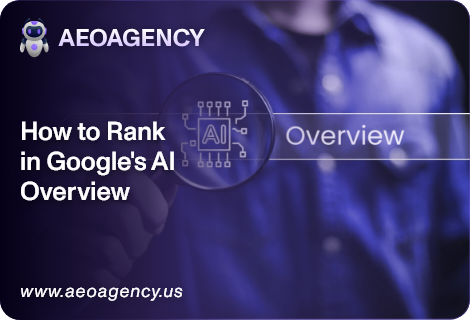As Google continues to integrate AI deeply into its search engine, understanding how to rank in Google’s AI Overview (SGE) is now essential for SEOs, marketers, and content creators. The Search Generative Experience (SGE) isn’t just a feature; it’s the future of how users interact with Google Search. In 2025, success online depends on knowing how to optimize for Google SGE and leverage AI-powered insights.
In this guide, we’ll break down what Google SGE ranking means, how it differs from traditional SEO, and the best practices to rank in Google’s SGE module. Whether you’re running a small blog or a large content team, this step-by-step blueprint will equip you with the right tools and strategies to thrive in AI-driven SERPs.
Powered by AEO Agency, a leading name in AI-driven search optimization.
What is Google SGE (Search Generative Experience)?
Google SGE is an AI-powered search feature that provides conversational summaries and insights right at the top of search results. Instead of just showing blue links, SGE offers generative AI responses that blend information from multiple web sources.
For example, if you search “best productivity tools for remote teams,” SGE might summarize options with pros and cons from several top-ranking articles.
Why It Matters in 2025
- Over 65% of U.S. users say they prefer summarized AI answers for complex questions (Source: Statista, 2025).
- AI Overview often occupies the top space in SERPs—pushing down traditional #1 results.
- If you’re not in the SGE module, you’re missing clicks, traffic, and visibility.
What Is Required to Rank in Google’s AI Overview?
To rank in Google AI Overview, you need to move beyond old-school keyword stuffing and embrace a semantic, intent-focused content strategy.
Here’s how.
1. Match Search Intent Better Than Ever
SGE thrives on user intent. You must deeply understand why someone is searching, not just what they’re searching for.
Actionable Tip:
Use tools like Google’s People Also Ask, Answer the Public, and AlsoAsked to discover related questions and subtopics. These help you target informational and long-tail queries like:
- “How to appear in Google’s AI Overview results”
- “SEO tactics for Google’s Search Generative Experience”
Pro Tip:
Format your content with clear subheadings (H2/H3) that reflect common user questions. This supports AI Overview SEO by making your content easier for Google to extract and summarize.
2. Implement Semantic SEO and Entity-Based Optimization
SGE pulls information based on topics and entities, not just keywords. This means Google needs to recognize the relationships between ideas in your content.
How to Do This:
- Use Latent Semantic Indexing (LSI) keywords to strengthen topical authority.
- Link out to authoritative sources (like gov, edu, or trusted industry sites).
- Define key terms and include contextual clues (dates, stats, locations, uses).
For example, instead of just saying “AI SEO,” include “AI SEO strategy for content creators in 2025.”
Keyword Integration Example:
“Implementing a robust SGE SEO strategy means optimizing your content not just for exact-match keywords, but for how users naturally ask questions in the AI-powered SERP.”
3. Use Structured Content and Featured Snippet Format
The AI Overview loves structured, skimmable, and snippet-ready content.
How to Structure Content for Google SGE Optimization:
- Use bullet points and numbered lists
- Keep answers concise (40-60 words) for quick summaries
- Add FAQs at the end of your posts
- Use bolded subheadings and plain-language answers
Why This Matters:
Content formatted for featured snippets in SGE is more likely to be chosen by Google’s generative engine for AI summaries.
4. Boost Your E-E-A-T: Experience, Expertise, Authoritativeness, Trust
Even in 2025, Google uses E-E-A-T signals to judge content quality.
To rank in Google SGE:
- Add author bios with credentials
- Use external citations and references
- Showcase case studies, testimonials, and original data
- Keep content updated regularly
Did you know? Google’s AI Overview is less likely to feature outdated content—relevancy and freshness are key SGE ranking factors in 2025.
5. Prioritize Page Experience & Load Speed
While content is king, site performance still matters. Slow, cluttered pages are unlikely to be featured in AI Overviews.
Technical Tips:
- Improve mobile experience (use Google’s Core Web Vitals report)
- Compress images and eliminate render-blocking JavaScript
- Ensure your page loads within under 2 seconds
Bonus:
Use schema markups like FAQPage, HowTo, and Article to make your content machine-readable for Google AI search optimization.
6. Align with Conversational AI Patterns
Remember, SGE is generative. Your content should feel natural, conversational, and complete.
Use formats like:
- “Let’s explore…”
- “Here’s what you need to know…”
- “According to experts…”
These mimic human speech and increase your content’s chance to appear in AI-powered search ranking modules.
7. Monitor and Measure: What’s Working?
To stay competitive, use tools like:
- Google Search Console (for impression data in AI modules)
- Ahrefs or Semrush to monitor keyword movement
- SEO plugins like RankMath or Yoast to keep content optimized
And don’t forget manual SGE testing:
Google your target keyword and analyze how the SGE response is structured. What types of content are being pulled in? What format do they follow?
Summary Checklist: How to Rank in Google SGE
| Strategy | Priority |
|---|---|
| Answer search intent clearly | ✅ High |
| Use semantic & entity SEO | ✅ High |
| Format for snippets (bullet points, lists) | ✅ High |
| Optimize E-E-A-T | ✅ Medium |
| Improve site speed & UX | ✅ Medium |
| Add schema markup | ✅ Medium |
| Use a conversational tone | ✅ Medium |
| Update content regularly | ✅ Ongoing |
Final Thoughts
Mastering how to rank in Google SGE in 2025 means adopting a future-facing mindset. AI search isn’t coming, it’s already here. Your SEO strategy must evolve to prioritize semantic understanding, user-focused content, and technical precision.
The sooner you start implementing these SGE SEO strategy principles, the sooner you’ll see better visibility and traffic from Google’s AI search results.
AEO Agency is here to help businesses adapt to this AI-driven search evolution with proven, ethical SEO tactics that work in 2025 and beyond.
Need help optimizing your site for Google SGE?
Let us guide you with an expert audit customized to the new AI Overview standards.

